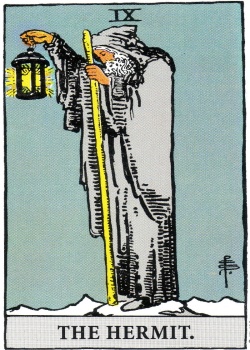Hermit: Difference between revisions
No edit summary |
No edit summary |
||
| Line 23: | Line 23: | ||
<blockquote>"By comparing this card with two others, the sixth and the twelfth, we shall see that the beardless young man in the former (6th) has chosen the right path. Experience won in the labour of life has rendered him a prudent old man, and prudence united to wisdom will safely lead him to the higher level, which he is anxious to attain (12th card)." <ref>Papus, The Tarot of the Bohemians (Wilshire Book Co, 1978), https://sacred-texts.com/tarot/tob/index.htm. p. 116.</ref></blockquote> | <blockquote>"By comparing this card with two others, the sixth and the twelfth, we shall see that the beardless young man in the former (6th) has chosen the right path. Experience won in the labour of life has rendered him a prudent old man, and prudence united to wisdom will safely lead him to the higher level, which he is anxious to attain (12th card)." <ref>Papus, The Tarot of the Bohemians (Wilshire Book Co, 1978), https://sacred-texts.com/tarot/tob/index.htm. p. 116.</ref></blockquote> | ||
Constitutes the individual as an "eternal seeker" always on path of improvement. The Fool in School. "He is the eternal seeker, the Pilgrim soul."<Ref>Wang, Robert. An Introduction to the Golden Dawn Tarot. Main: Sam Weiser, 1978. p. 128. </ref> | |||
===[[Book of Slavery]]=== | ===[[Book of Slavery]]=== | ||
Revision as of 14:54, 13 July 2020
The Hermit is an Old Energy Archetype from the Masonic Tarot Deck. In the Book of Power, the archetype is typically used to enforce notions of initiation and progress on the esoteric path. In the Book of Slavery...
List of Old Energy Archetypes from the Masonic Tarot
Chariot, Death (archetype), Duality, Hermit, Hierophant, High Priestess, Judgement, Justice, Star, Strength, Sun (archetype), Temperance, The Devil, The Emperor, The Empress, The Fool, The Hanged Man, The Lovers, The Magician, The Moon, The Tower, The Wheel of Fortune, The World (old energy)
Related Terms
Old Energy Archetypes > Book of Slavery
Notes
Book of Power
A template for brainwashing: The initiate's opinions are formed by a "plumb line" that leads them to "voluntarily" accept certain conclusions. Notice the reference to a "plumb line." They say we are encouraged to come to our own conclusions, but the "plumb line" leads us in a direction. We become masters only if we follow the line.
"(The Hermit, Wise man whose influence works discreetly and irresistibly. The Master who has reached complete mastership.) As he works the Initiate reflects. He refuses to act like a machine. The artist is interested in his work, which he loves and understands because he feels it. Rules are not imposed upon him superficially, for he has assimilated them by the process of thoughtful and logical justification. The 'Plumb Line' has directed his mind into the inner area of things, towards Esotericism which escapes the uninitiated."[1]
Success in following the "right" path, a path laid out by the plumb line.
"By comparing this card with two others, the sixth and the twelfth, we shall see that the beardless young man in the former (6th) has chosen the right path. Experience won in the labour of life has rendered him a prudent old man, and prudence united to wisdom will safely lead him to the higher level, which he is anxious to attain (12th card)." [2]
Constitutes the individual as an "eternal seeker" always on path of improvement. The Fool in School. "He is the eternal seeker, the Pilgrim soul."[3]
Book of Slavery
Sexism, God as male patriarch. "The Hermit is the Ancient One, the Source of all existence, above all things, yet supporting all. He precedes everything....the Absolute is the Father, or Progenitor, of all things.
Fool in school "Here is the Great Promise. In humanity are the potencies of Divinity, to be evolved by climbing the steeps of experience; and the end of the Path is union with our Source." [4]
Recovery
Representing isolation, withdrawal for the purposes of establishing connection.
". Primarily, the card means a withdrawal from the outer world for the purpose of activating the unconscious mind." [5]
" On the one hand it symbolizes a withdrawal from outer concerns. The person may physically remove himself, but this is not really necessary. What matters is the inner transfer of attention from 'getting and spending' as Wordsworth called our worldly activities, to a person's inner needs. It therefore requires an emotional withdrawal from other people and from activities once thought to be all-important. The card carries within it a sense of deliberate purpose, of withdrawing to work on self-development"[6]
Footnotes
- ↑ Wirth, Oswald. Tarot of the Magicians: The Occult Symbols of the Major Arcana That Inspired Modern Tarot. San Francisco. CA: Weiser Books, 1990. p. 171,
- ↑ Papus, The Tarot of the Bohemians (Wilshire Book Co, 1978), https://sacred-texts.com/tarot/tob/index.htm. p. 116.
- ↑ Wang, Robert. An Introduction to the Golden Dawn Tarot. Main: Sam Weiser, 1978. p. 128.
- ↑ Case, Paul Foster. An Introduction to the Study of the Tarot. New York: Kindle Edition, 1920. p. 32.
- ↑ Pollack, Rachel. Seventy-Eight Degrees of Wisdom. Harper Collins, 1980. p. 77
- ↑ Pollack, Rachel. Seventy-Eight Degrees of Wisdom. Harper Collins, 1980. p. 81
[Is related to::Fool in School| ]]
{{#seo:
|author="Mike Sosteric"
|title=Tarot Card Meanings Old Energy
|title_mode=append
|keywords=tarot, freemasons, freemasonry
|site_name=The SpiritWiki
|description=The Old Energy Masonic Meanings of the Hermit Tarot Card
}}
